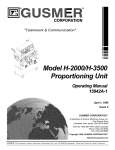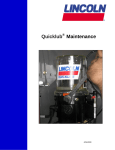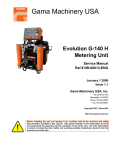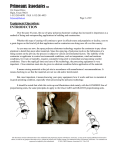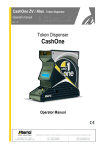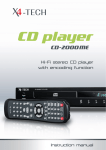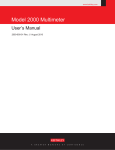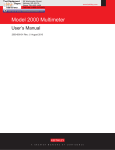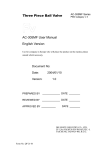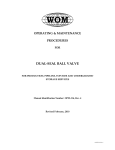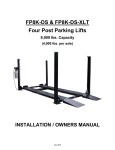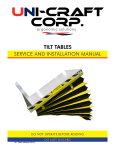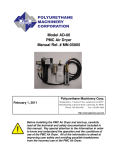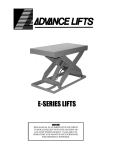Download Model H-II Proportioning Unit Operating Manual
Transcript
"Teamwork & Communication" Model H-II Proportioning Unit Operating Manual 1940-1 May 17, 2001 Issue 2 GUSMER CORPORATION ® A Subsidiary of Gusmer Machinery Group, Inc. One Gusmer Drive Lakewood, New Jersey, USA 08701-8055 Toll Free 1-800-367-4767 (USA & Canada) Phone: (732) 370-9000 Fax: (732) 905-8968 Copyright 2001, GUSMER CORPORATION ® http://www.gusmer.com NOTICE: This manual contains important information for your GUSMER equipment. Read and retain for future reference. Model H-II Proportioning Unit NOTICE: THE EQUIPMENT DESCRIBED IN THIS TECHNICAL MANUAL MUST ONLY BE OPERATED OR SERVICED BY PROPERLY TRAINED INDIVIDUALS, THOROUGHLY FAMILIAR WITH THE OPERATING INSTRUCTIONS AND LIMITATIONS OF THE EQUIPMENT. FOR TECHNICAL SERVICE, CALL YOUR LOCAL DISTRIBUTOR. CALL: 1-800-FOR-GSMR (1-800-367-4767) FOR THE NAME AND TELEPHONE NUMBER OF YOUR LOCAL DISTRIBUTOR. NOTICE: ALL STATEMENTS, INFORMATION AND DATA GIVEN HEREIN ARE BELIEVED TO BE ACCURATE AND RELIABLE BUT ARE PRESENTED WITHOUT GUARANTEE, WARRANTY OR RESPONSIBILITY OF ANY KIND EXPRESSED OR IMPLIED. STATEMENTS OR SUGGESTIONS CONCERNING POSSIBLE USE OF GUSMER EQUIPMENT ARE MADE WITHOUT REPRESENTATION OR WARRANTY THAT ANY SUCH USE IS FREE OF PATENT INFRINGEMENT, AND ARE NOT RECOMMENDATIONS TO INFRINGE ANY PATENT. THE USER SHOULD NOT ASSUME THAT ALL SAFETY MEASURES ARE INDICATED OR THAT OTHER MEASURES MAY NOT BE REQUIRED 2 1940-1, Issue 2 Operating Manual Content CONTENTS WARRANTY.............................................................................................................................5 GENERAL SAFETY INFORMATION..................................................................................6 ACCEPTABLE EQUIPMENT USES ...............................................................................................6 OPERATIONAL SAFETY PROCEDURES .......................................................................................7 KEY FEATURES ......................................................................................................................8 PROPORTIONING PUMP .............................................................................................................8 PRIMARY HEATER ....................................................................................................................8 HOSE HEATER ..........................................................................................................................8 DESCRIPTION OF CONTROLS ...........................................................................................9 SPECIFICATIONS .................................................................................................................11 INITIAL MACHINE SET-UP ...............................................................................................13 NORMAL OPERATING PROCEDURES ...........................................................................19 DAILY START-UP PROCEDURES .............................................................................................19 DAILY SHUT-DOWN PROCEDURES .........................................................................................20 TROUBLE SHOOTING PROCEDURES ............................................................................21 GENERAL INTRODUCTION ......................................................................................................21 PRIMARY HEATER ..................................................................................................................23 PROPORTIONING SYSTEM .......................................................................................................25 HYDRAULIC DRIVE SYSTEM...................................................................................................30 MAINTENANCE ....................................................................................................................31 PUMP LUBE SYSTEM ..............................................................................................................31 INLET STRAINER SCREEN .......................................................................................................32 HYDRAULIC SYSTEM..............................................................................................................33 PROPORTIONING PUMPS .........................................................................................................34 PUMP BASES ..........................................................................................................................34 PRIMARY HEATERS ................................................................................................................35 APPENDIX ..............................................................................................................................37 NOTES .....................................................................................................................................38 INSTRUCTION MANUAL DISCREPANCY REPORT ....................................................39 5/17/01 3 Model H-II Proportioning Unit LIST OF FIGURES FIGURE 1. DESCRIPTION OF CONTROLS H-II PROPORTIONING UNITS. .......................................9 FIGURE 2. TYPICAL INSTALLATION ...........................................................................................13 FIGURE 3. POWER CORD STRAIN RELIEF...................................................................................14 FIGURE 4. HYDRAULIC PUMP FILL ............................................................................................14 FIGURE 5. LUBE RESERVOIR .....................................................................................................15 FIGURE 6. HOSE CONNECTION ..................................................................................................15 FIGURE 7. HOSE CONNECTION STEP (A)....................................................................................15 FIGURE 8. HOSE CONNECTION STEP (B) ....................................................................................16 FIGURE 9. HOSE CONNECTION STEP (C) ....................................................................................16 FIGURE 10. HOSE CONNECTION STEP (D)..................................................................................16 FIGURE 11. BELL HOUSING .......................................................................................................16 FIGURE 12. TAP SETTINGS (SINGLE TRANSFORMER) ................................................................18 FIGURE 13. DIRECTIONAL INDICATOR LIGHTS & REVERSING SWITCH ROCKER ARM...............20 FIGURE 14. PRIMARY HEATER ..................................................................................................23 FIGURE 15. PROPORTIONING SYSTEM .......................................................................................25 FIGURE 16. BALL VALVE ASSEMBLY ........................................................................................27 FIGURE 17. HYDRAULIC MANIFOLD..........................................................................................28 FIGURE 18. CONTROL TRANSFORMER FUSE ..............................................................................29 FIGURE 19. POWER CONTACTOR ...............................................................................................30 FIGURE 20. LUBE HOSE.............................................................................................................31 FIGURE 21. INLET FILTER ..........................................................................................................32 FIGURE 22. HYDRAULIC SYSTEM ..............................................................................................33 FIGURE 23. HYDRAULIC PUMP FILL ..........................................................................................33 FIGURE 24. PUMP BASE BALL VALVE .......................................................................................34 FIGURE 25. PRIMARY HEATERS ................................................................................................35 LIST OF TABLES TABLE 1. TAP SETTINGS (SINGLE TRANSFORMER) ...................................................................18 TABLE 2. HEATER RESISTANCE ................................................................................................24 4 1940-1, Issue 2 Operating Manual Warranty WARRANTY Gusmer Corporation (Gusmer) provides a limited warranty to the original purchaser (Customer) of Gusmer manufactured parts and equipment (Product) against any defects in material or workmanship for a period of one year from the date of shipment from Gusmer facilities. In the event Product is suspected to be defective in material or workmanship, it must be returned to Gusmer, freight prepaid. If Product is found to be defective in material or workmanship, as determined solely by Gusmer, Gusmer will issue full credit to Customer for the freight charges incurred in returning the defective Product, and either credit will be issued for the replacement cost of the Product or a replacement part will be forwarded no-charge, freight prepaid to Customer. This warranty shall not apply to Product Gusmer finds to be defective resulting from: installation, use, maintenance, or procedures not accomplished in accordance with our instructions; normal wear; accident; negligence; alterations not authorized in writing by Gusmer; use of “look alike” parts not manufactured or supplied by Gusmer; or Product used in conjunction with any other manufacturer's pumping or proportioning equipment. Further, the terms and conditions of this warranty shall not apply to services or repairs made to Product by any third party not authorized in writing by Gusmer. For such Product, a written estimate will be submitted to Customer at a nominal service charge, itemizing the cost for repair. Disposition of Product will be done in accordance with the terms stated on the written estimate. The warranty provisions applied to product that are not manufactured by Gusmer will be solely in accordance with the warranty provided by the original manufacturer of the product. GUSMER MAKES NO WARRANTY WHATSOEVER AS TO THE MERCHANTABILITY OF, OR SUITABILITY FOR, ITS PRODUCT TO PERFORM ANY PARTICULAR PURPOSE. CREDIT FOR, OR REPLACEMENT OF, PRODUCT DEFECTIVE IN MATERIAL OR WORKMANSHIP SHALL CONSTITUTE COMPLETE FULFILLMENT OF GUSMER OBLIGATIONS TO CUSTOMER. NO OTHER WARRANTY, EXPRESS OR IMPLIED ON ANY PRODUCT IT MANUFACTURES AND/OR SELLS, WILL BE RECOGNIZED BY GUSMER UNLESS SAID WARRANTY IS IN WRITING AND APPROVED BY AN OFFICER OF GUSMER. Under no circumstances shall Gusmer be liable for loss of prospective or speculative profits, or special, indirect, incidental or consequential damages. Further, Gusmer shall have no liability for any expenses including, but not limited to personal injury or property damage resulting from failure of performance of the product, use of the product, or application of the material dispensed through the product. Any information provided by Gusmer that is based on data received from a third source, or that pertains to product not manufactured by Gusmer, while believed to be accurate and reliable, is presented without guarantee, warranty, or responsibility of any kind, expressed or implied. Gusmer through the sale, lease, or rental of Product in no way expresses or implies a license for the use of, nor encourages the infringement of any patents or licenses. To insure proper validation of your warranty, please complete the warranty card and return it to Gusmer within two weeks of receipt of equipment. Revised 11/12/98 5/17/01 5 Model H-II Proportioning Unit GENERAL SAFETY INFORMATION It is necessary to understand and follow the instructions in this manual to insure proper and safe operation of the equipment. As with most mechanical equipment, certain safety precautions must be taken when the equipment discussed in this manual is operated or serviced. Severe bodily injury or damage to equipment and property may result if the instructions and precautions listed throughout this manual are not followed. Needless to say, sufficient guidelines cannot be developed to eliminate the need for good common sense in the use and servicing of this equipment, and in the use and application of the products, this equipment has been designed to process. Users of this equipment must therefore, make their own determination as to the suitability of the information contained in this manual to their specific operation and requirements. There should be no assumption made that the safety measures and instructions contained herein are allinclusive, and that other safety measures may not be required for specific use or application. The following safety guidelines are generally applicable to the safe and efficient use of the equipment. Acceptable Equipment Uses The equipment is designed for the dispensing of polyurethane foams, two-component coating systems, and some two-component epoxy systems, specifically polyureas. Under no circumstances should any acid or corrosive chemicals be used in the unit. Consult GUSMER if there is any doubt about the compatibility of the chemical system to be used in this equipment. Any use of this equipment other than as indicated above constitutes misuse unless express written approval is obtained from GUSMER. 6 1940-1, Issue 2 Operating Manual General Safety Information Operational Safety Procedures This safety information will not be repeated in the text of this manual. The symbols pertaining to this information will appear where appropriate to alert the operator to potential hazards. Solvents and Chemicals WARNING: THE SOVENTS AND CHEMICAL USED WITH THIS EQUIPMENT EXPOSE THE OPERATOR TO CERTAIN HAZARDS. ADEQUATE PERSONAL PROTECTIVE MEASURES MUST BETAKEN SO AS TO AVOID EXCEEDING THE THRESHOLD LIMIT VALUE (TLV) OF THE PRODUCTS BEING USED, AS ESTABLISHED BY THE OCCUPATIONAL SAFETY AND HEALTH ADMINISTRATION (OSHA) OR OTHER QUALIFIED AGENCY. INFORMATION CONCERNING PERSONAL PROTECTION AND PROPER HANDLING FROM THE SUPPLIER OF SUCH CHEMICALS. High Voltage WARNING: TO PREVENT SERIOUS BODILY INJURY FROM ELECTRICAL SHOCK, NEVER OPEN THE ELECTRIC CONSOLES OR OTHERWISE SERVICE THIS EQUIPMENT AND/OR EQUIPMENT USED WITH IT BEFORE SWITCHING OFF THE MAIN POWER DISCONNECT AND INTERRUPTING SUPPLY VOLTAGE AT THE SOURCE. THE ELECTRICAL SERVICE MUST BE INSTALLED AND MAINTAINED BY A QUALIFIED ELECTRICIAN. WARNING: THIS EQUIPMENT HAS OR IS USED WITH EQUIPMENT THAT HAS HYDRAULIC COMPONENTS CAPABLE OF PRODUCING UP TO 3500 PSI. TO AVOID SERIOUS BODILY INJURY FROM HYDRAULIC INJECTION OF FLUID, NEVER OPEN ANY HYDRAULIC CONNECTIONS OR SERVICE HYDRAULIC COMPONENTS WITHOUT BLEEDING ALL PRESSURES TO ZERO. High Pressure WARNING: TO AVOID SERIOUS BODILY INJURY, PROPER PROTECTIVE GEAR MUST BE WORN WHEN OPERATING, SERVICING, OR BEING PRESENT IN THE OPERATIONAL ZONE OF THIS EQUIPMENT. THIS INCLUDES, BUT IS NOT LIMITED TO, EYE AND FACE PROTECTION, GLOVES, SAFETY SHOES, AND RESPIRATORY EQUIPMENT AS REQUIRED. Personal Protective Equipment WARNING: THIS EQUIPMENT HAS OR IS USED WITH EQUIPMENT THAT HAS HIGH TEMPERATURE COMPONENTS SUCH AS PRIMARY HEATERS AND HEATED HOSES. TO PREVENT SERIOUS BODILY INJURY FROM HOT FLUID OR HOT METAL, NEVER ATTEMPT TO SERVICE THE EQUIPMENT BEFORE ALLOWING IT TO COOL. High Temperature WARNING: FAILURE TO READ AND FOLLOW THIS SAFETY INFORMATION MAY RESULT IN PERSONAL INJURY AND/OR DAMAGE TO THE EQUIPMENT FROM ONE OR MORE OF THE ABOVE LISTED HAZARDS Warning 5/17/01 7 Model H-II Proportioning Unit KEY FEATURES The Gusmer Model H-II Proportioning Unit can process a wide range of plural component systems, each with their unique characteristics. The H-II incorporates the proven principles of its predecessors enhanced by many technical innovations specifically developed to provide high pressure for mixing and atomizing, ratio change, pre-mix chemical temperature control, and ease of maintenance. Proportioning Pump The proportioning pumps are positive displacement, double acting piston pumps. The proportioning pumps operate at working pressures up to 1000 psi. Both the pump cylinder and piston shaft are specially treated to resist wear, and incorporate field proven Gusmer self adjusting packings. The pump base is external to the proportioning the pump. To facilitate servicing, the pump base features externally accessible valve balls. Protection of the environment on the external side of the pump cylinder packings is very important. The A-proportioning pump contains a continuous flow, liquid lubrication system. In addition, a RETRACT switch provides for shutdown of the proportioning unit with the isocyanate pump shaft completely retracted within the pump cylinder. Primary Heater An individual bimetallic thermostat controls the temperature of each primary heater, which the operator adjusts to establish the desired set point. Maintenance of the heater is basic. The heating elements are externally accessible and if necessary, disassembling, cleaning, and reassembling the entire heater requires only the replacement of 3 o-rings. Hose Heater The hose heating system is the proven safe and reliable Gusmer LOW VOLTAGE hose heater. An isolation transformer supplies the power for the system, which physically separates the high voltage from the operator. The uniquely designed gun hose serves a three fold purpose: NOTE: as a rule of thumb, the hose thermometer reads approximately 20° less than the actual fluid temperature within the heated hose. 8 • Provide heat right to the gun • Isolate the gun from the low voltage circuit • Bleed off any static charges. Adjustment of the temperature control on the hose heater is manual and under certain operating conditions may require operator adjustment to compensate for changes in surrounding air temperature. To maintain hose temperatures adjust the hose temperature control to the desired amperage reading. Hose thermometer inserted in the rubber insulation jacket of the heated hose indicates the temperature of the hose, near the gun. 1940-1, Issue 2 Operating Manual Description of Controls DESCRIPTION OF CONTROLS Figure 1. Description Of Controls H-II Proportioning Units. 1 2 5/17/01 MAIN CIRCUIT BREAKER Controls and protects power to all circuits; must be ON for any function of the proportioning unit to operate. Pilot light (White) Indicates when lighted that the main circuit breaker is on. MOTOR CONTROL Controls power to the electric motor; must be ON for the hydraulic drive system to operate Pilot light (Blue) Indicates when lighted that the electric motor is on. 9 Model H-II Proportioning Unit 3 PUMP SWITCH Controls operation of the hydraulic drive system OFF Hydraulic Directional Drive System is off, and hydraulic pressure is not in this position. NORMAL Must be in this position for the proportioning pumps to operate. RETRACT Use this position for shutdown. It will stop the hydraulic drive system with the Aproportioning pump in the retracted position. 4 PUMP DIRECTIONAL INDICATOR LIGHTS (Amber) Indicates the direction of proportioning pump travel; both lights will be off when the pump switch is OFF or when either proportioning pump exceeds its safe operating pressure limitation. 5 COUNTER Records the cycle count of the proportioning pumps; one cycle equals two (2) strokes (one in each direction). 6 R-PRIMARY HEATER CIRCUIT BREAKER Controls and protects power to the R-primary heater; must be ON for the primary heater to operate. Pilot light (Blue) Indicates when lighted that the R-Primary Heater Circuit Breaker is on. Auto trip The Primary Heater Circuit Breaker will automatically trip to OFF when the temperature of the primary heater exceeds the safe operating limitations. 7 A-PRIMARY HEATER CIRCUIT BREAKER 8 HOSE HEATER CIRCUIT BREAKER Controls and protects power to the hose heater; must be ON for the hose heater to operate. Pilot light (Blue) Indicates when lighted that the Hose Heater Circuit Breaker is on. 9 HOSE HEATER CONTROL Controls the power to the hose heat circuit, thus controlling the temperature of the liquid in the heated hoses. Turn the control selector to adjust the amperage reading on the Hose Heater Ammeter. 10 HOSE HEATER AMMETER Indicates the amount of heating power delivered to the hose heater. 11 HYDRAULIC PRESSURE CONTROL Controls the hydraulic pressure available to the hydraulic drive system. This control automatically limits the maximum pressure available to within the safe operating limitations. Set pump switch to RETRACT and adjust clockwise to increase pressure, counter clockwise to decrease pressure. 12 HYDRAULIC PRESSURE GAUGE Indicates the pressure in the hydraulic drive system. 13 RESIN PRESSURE GAUGE Indicates the pressure in the resin proportioning system. 14 ISOCYANATE PRESSURE GAUGE Indicates the pressure in the isocyanate proportioning system. 15 R-INLET SUPPLY VALVE 16 A-INLET SUPPLY VALVE (Not Shown) 10 1940-1, Issue 2 Operating Manual Specifications SPECIFICATIONS ENVIRONMENT: The equipment is not of explosion proof design and should never be used in an atmosphere requiring this design. RECOMMENDED USE: This equipment design is for use with “standard” urethane foam pour, froth pour, and spray systems. Other use of the equipment, or any part thereof, constitutes misuse unless expressed written approval from Gusmer. Some plural component systems available for use with this equipment contain abrasives. Although the equipment is abrasion resistant, it is not abrasion proof, so those parts damaged; because of using abrasive materials will not be covered under warranty. SAFETY EQUIPMENT: To prevent skin and eye contact with the chemicals or solvents used in or with this equipment, wear sufficient protective clothing when servicing or operating the equipment. Wear approved safety glasses or goggles when servicing or operating the equipment. Respiratory protection, capable of providing sufficient filtration to prevent inhalation of toxic vapors emitted from the chemical system being used, must be worn by any and all persons in the vicinity of any operation where equipment is operated. In poorly ventilated areas, GUSMER recommends use of a fresh air type of respirator system. APPLICATION: Due to the potential fire hazard of exposed urethane foam, follow all procedural and safety directives for storage, handling, and application of the chemicals used with this equipment. WARNING: INFORMATION CONCERNING PERSONAL PROTECTION AND PROPER HANDLING AND APPLICATION PROCEDURES OF THE CHEMICALS AND SOLVENTS USED WITH THIS EQUIPMENT MUST BE OBTAINED FROM THE SUPPLIERS OF SUCH CHEMICALS AND SOLVENTS. ELECTRIC: The electric requirements are: 3 HP 70 amperes at 220 volts, 60-HZ, single phase, AC current, 70 amperes main circuit breaker protection (3 HP, 70 amperes at 220 volts, 50HZ, single phase AC current is an available option.) Connect incoming power directly to the main terminal block. The use of UL® approved wire size 4/3 or larger is recommended. The length should be as short as possible to minimize voltage drop. WARNING: DAMAGE TO THE EQUIPMENT COULD RESULT IF THE UNIT IS OPERATED AT OTHER THAN THE NAME PLATE VOLTAGE. AIR: The Model H-II is hydraulically driven. There are no air requirements for the proportioner itself. MATERIAL SUPPLY: Protect the chemical supply from moisture in the atmosphere by a blanket of dry nitrogen or desiccated air. Resin Inlet-3/4" NPT (FE) swivel Isocyanate Inlet-1/2" NPT (FE) swivel 5/17/01 11 Model H-II Proportioning Unit CHEMICAL VISCOSITY: No maximum limitation has been established and, assuming adequate supply, viscosity’s of 2,500 cps or more may be possible. HYDRAULIC SERVICING: 16 gallons (62 Liters) Recommended operating temperature: 120°F (48°C) Maximum operating temperature: 160°F (71°C) WEIGHT: Empty: 325 pounds (147 kilograms) Serviced: 425 pounds (190 kilograms) DIMENSIONS: Height: 47 inches (119 centimeters) Width: 40 inches (102 centimeters) Depth: 22 inches (56 centimeters) OPERATING PRESSURE: 1000 psi maximum (68 Bars) SUPPLY PRESSURE: 250 psi maximum (17 Bars) OUTPUT: 25 lb./min. maximum (11 kg/min.) 21 lb./min. maximum (9.5 kg/min.) INLET FILTER: 80 Mesh PRIMARY HEATER: 5000 Watts per heater at 220 Volts. HOSE LENGTH: 210 feet (64 meters) maximum for heating purposes 12 1940-1, Issue 2 Operating Manual Initial Machine Set-Up INITIAL MACHINE SET-UP Figure 2. Typical Installation 5/17/01 13 Model H-II Proportioning Unit WARNING: PROPER PROTECTIVE GEAR MUST BE WORN WHEN SERVICING OR OPERATING THIS EQUIPMENT, WHICH INCLUDES BUT IS NOT LIMITED TO GLOVES, EYE PROTECTION, AND RESPIRATORY PROTECTION AS REQUIRED. An Accessory Package is included with the unit and contains the following parts that are required for setup: • Tape Roll • Lube Bottle • Electrical Isolator • Button Head Cap Screw • (2) Swivel Unions • Operating Manual • Isolation Hoses Blue - Resin Red - Isocyanate • Parts Identification Manual • Binder • Warranty Card • Lube Reservoir * Refer to Figure 2 for additional parts required for set-up. WARNING: THE ELECTRIC SERVICE MUST BE DONE BY A QUALIFIED ELECTRICIAN. NOTE: The power source must be capable of meeting the electrical requirements specified on the nameplate of the proportioning unit and provide an accessible Quick Disconnect. NOTE: Loose assembly of the Material Supply Valves to the unit is sot they may be oriented in the position that best suits the setup. 1. Connect the main power cord (not supplied) to the electric console using 4/3 wire size or larger. The power cord must be UL approved (or equivalent). Open the electric console. Feed the power cord through the strain relief and connect the power leads to the lugs on the bottom of the Main Circuit Breaker and the ground (white) lead to the grounding lug. Figure 3. Power Cord Strain Relief 2. Set up the supply and moisture control systems as required. Refer to the individual instruction manuals for the proper procedures. 3. Fill the hydraulic reservoir through the vented filler neck with approximately 16 gallons of hydraulic fluid. Refer to the listing in Appendix B for the recommended types of fluid. Important: DO NOT overfill. When the filler neck is approximately ½ filled with liquid the reservoir is full. 4. Remove the 90° elbow fitting from the top of the pump and determine that the fluid level is to the top of the threaded hole. Add fluid as required and replace the fitting. Figure 4. Hydraulic Pump Fill 14 1940-1, Issue 2 Operating Manual Initial Machine Set-Up 5. Install the pump lube reservoir bracket. Thread the lube bottle onto the reservoir cap assembly and place into the bracket Figure 5. Lube Reservoir 6. Connect the isolation hoses to their respective primary heaters. Connect the hose heater wire leads to each isolation hose. Take care to make the connection tight. It is a good idea to apply electrical tape to the connection to prevent loosening from vibration. Figure 6. Hose Connection Important: Every precaution has been taken to prevent the inadvertent connection of a hose to the wrong chemical source. The resin hoses are color-coded blue ant the isocyanate hoses are color-coded red for easy identification. In addition, the resin and isocyanate hose fittings thread sizes are different, making it virtually impossible to improperly connect the hoses. The Resin thread is 9/16-18, whereas the Isocyanate thread is 1/2-20. NOTE: The hoses are connected end to end during shipment to protect them from moisture intrusion. Do not separate the hoses until it is time to couple them to the proportioning unit. 7. Connect the heated hose assemblies. Important: It is not possible to over emphasize the importance of making proper hose connections. The connection points are a potential source of chemical and air leaks and exposed to damage from scuffing and snagging on abrasive surfaces. A liberal amount of duct tape can be used in this area to make the bundle as compact as possible. GUSMER strongly recommends installing the optional scuff jacket to protect the hose insulation and TSU extension from damage. A proper hose connection is shown in sequence on the following page The key areas of extra attention during installation are as follows: a) DO NOT interchange the hoses: Resin hoses are colorcoded BLUE, Isocyanate hoses are color-coded RED. Figure 7. Hose Connection Step (a) 5/17/01 15 Model H-II Proportioning Unit b) To assure leak proof chemical connection be careful not too cross-thread the fitting and DO NOT over-tighten. Figure 8. Hose Connection Step (b) c) Tape the electrical isolator securely in place between the hydraulic fittings: failure to do so will cause a short circuit in the hose heating system. Figure 9. Hose Connection Step (c) d) To assure a secure electrical connection: place the protective electrical isolator boot over each plug and tape together. Figure 10. Hose Connection Step (d) *** Repeat Step 7 for adding additional hoses. *** NOTE: Power lead L3 is not used for single-phase installation. Connect the ground wire to the ground lug. Close the electric control console. Important: (for 3 phase units only) At this point it is necessary to check the rotation of the electric motor. An arrow located on the hydraulic pump and on the Bell Housing indicates the correct direction of rotation. Perform steps 10, 11, 12, 13. 8. Remove the Bell Housing Safety Plug to allow you to see the shaft coupling. Turn the hydraulic pressure control counter clockwise to the end. Make sure the pump switch is in the OFF position. 9. Determine that all circuit breakers, on the main console, are OFF. Switch the main circuit breaker to ON. 10. While observing the shaft coupling, cycle the motor ON and OFF. The rotation of the coupling must agree with the directional indicator. If the rotation does not agree, turn off all circuit breakers and disconnect the main power at the source. Open the electric console and switch any two of the three power leads. Recheck the rotation. Figure 11. Bell Housing 11. Replace the plug in the motor bell housing. 16 1940-1, Issue 2 Operating Manual Initial Machine Set-Up 12. Connect the coupling block to the gun hose and determine that the manual valves are closed. 13. Insure proper grounding of all equipment. The high velocity flow of fluid can create static sparking which may cause fire or explosion. Certain solvents, which are commonly in use with this equipment are flammable and may present a flash danger to the operator. NOTE: Disposal of waste chemicals must be in accordance with local, state, and federal codes. a) The 2:1 Transfer Pump has a ground lug. Ground pump in accordance with the instructions provided with the pump. b) Ground the proportioner at the main electrical source. In the event, that the unit is being powered by a generator, the generator must also be grounded directly to a suitable electrical electrode such as an underground water system, the metal frame of a building, or a driven pipe. Electrodes of pipe or conduit shall not be smaller than ¾ inch diameter, galvanized for corrosion protection, and driven below the moisture level. For additional information, consult the National Electric Code. c) Connect the material supply system to the inlet of the proportioning unit. Exercise caution to ensure connecting chemicals to the appropriate proportioning pumps. We now have the proportioner, heated hose, and material supply system set up. Before the equipment is ready for use, it is necessary to purge the entire system of air and mineral oil left over from the functional testing of the equipment conducted at the factory. 14. To purge the machine proceed as follows: a) Pressurize the transfer pumps and open the material supply valves. It is a good practice at this point to check for hydraulic leaks. b) Determine that the hydraulic pressure control is full decrease (counter clockwise). c) Switch ON the main circuit breaker and motor control. d) With the Coupling Block Ports held over separate containers, open both manual valves. e) Switch the pump switch to the NORMAL Position. f) Allow both materials to flow out of the coupling block, until all spitting of air stops and all traces of residual material have disappeared. g) Switch the pump switch to OFF. h) Close both manual valves and flush any residual material from the outside of the coupling block. i) Mount the gun to the coupling block. Important: During the initial start-up, slowly increase the hydraulic pressure and check all fittings for signs of hydraulic and chemical leakage. Tighten as required. 5/17/01 17 Model H-II Proportioning Unit HOSE HEATER NOTE These procedures are not required on a daily basis but may have to be executed periodically as part of the daily start-up routine Adjust hose heater transformer tap settings to match the length of hose in use. Execute this procedure during the initial installation and any time the hose length is changed. Refer to the figure below. Table 1. Tap Settings (Single Transformer) NOTE: The default tap setting for the transformer is 10V Setting Voltage S1-S2 4.23 35 S2-S3 10.54 60 S1-S3 S3-S4 S2-S4 14.77 16.93 27.47 110 S1-S4 31.7 160 S4-S5 40.2 210 S3-S5 57.13 260 & Above S2-S5 S1-S5 67.67 71.9 Hose Length Feet Figure 12. Tap Settings (Single Transformer) 18 1940-1, Issue 2 Operating Manual Normal Operating Procedures NORMAL OPERATING PROCEDURES Daily Start-Up Procedures NOTE: The daily start-up procedures will describe normal operation and will assume proper execution of all calibrations and that the heating system is NOT up to required temperatures. 1. SERVICING-check the condition of the hydraulic and pump lubrication systems and service as required. Generally, change the lubricating fluid when it shows signs of color change. 2. SUPPLY-determine that the supply system is at the proper temperature recommended by the system supplier, that there is a proper mixture of individual chemicals within their drums, and that the moisture protection system is properly set for operation. 3. Check the inlet screens and service as required. 4. Pressurize the transfer pumps and open both Chemical Supply Valves. 5. Switch ON the main circuit breaker. The white pilot light should be on. NOTE: To prevent excessive pressure buildup in the dual heated hose, always bring the hose up to temperature before the Hydraulic system is turned on. The green pilot light, on the hose heater controller, will indicate that the liquid in the hose is up to temperature 6. Switch ON the Hose Heater Circuit Breaker and set the temperature controller as required. 7. When the liquid in the hose reaches the temperature selected, the green controller light will turn on and the ammeter will begin to cycle. NOTE: Primary heating is virtually instantaneous therefore, do not switch on the primary heaters until required for operation. It is also a good practice to turn off the primary heaters during shutdowns exceeding one half-hour. 8. Switch on the Primary Heater Circuit Breakers and set the temperature controllers as required. NOTE: The pump switch must be in the RETRACT or NORMAL position to adjust the hydraulic pressure. 9. The amber pilot light should be on as well as the amber controller light. The amber pilot light should be on as well as the amber controller lights. Switch ON the Motor control and set the hydraulic pressure as required. 10. Set the pump switch to the NORMAL position. One of the amber directional Indicator lamps will light and the proportioner pumps should move a short distance and pressurize. 5/17/01 19 Model H-II Proportioning Unit 11. Check the pressure of each proportioning pump. After setting the pump switch to NORMAL, observe both pressure gauges. The Resin and Isocyanate pressures should be approximately equal and the pressures must remain fixed. Observe the directional indicator lights and manually depress the reversing switch rocker arm, which corresponds to the light, which is off. Observe the pressures again; they must remain fixed. If the pressure bleeds off on either stroke, consult the Trouble Shooting Procedures before continuing. Figure 13. Directional Indicator Lights & Reversing Switch Rocker Arm 12. The proportioning unit is now ready for operation. Connect air to the gun. Following instructions in the gun manual, test spray. Daily Shut-Down Procedures 20 1. Set the pump switch to the RETRACT position. 2. Trigger the gun off target until the Isocyanate proportioning pump stops in the retracted position and the proportioning pump pressures bleed off to a point where the spray pattern begins to diminish. It is NOT a good practice to bleed the pressure to zero. Some pressure is required to keep the packings operating normally and prevent weepage during shutdown. 3. Switch OFF the motor control. 4. Switch OFF the hose heater and Primary Heater Circuit Breakers. 5. Switch OFF the main circuit breaker. 6. Close both Inlet Supply Valves. 7. SUPPLY - shut down the supply system as required. 8. GUN - shut down and service the gun as stated in the gun service manual. 1940-1, Issue 2 Operating Manual Troubleshooting Procedures TROUBLE SHOOTING PROCEDURES General Introduction When properly maintained and operated, Gusmer equipment will provide long and faithful service. However, occasional problems will arise which must be resolved before operation can continue. This section of the manual provides explanations for some problems that may arise, how to detect and resolve them. As when operating any piece of machinery, it is imperative to know what is normal operation in order to detected abnormal operation. Perhaps the best way to acquire knowledge of what is normal performance of Gusmer equipment is through experience in operating it “according to the book”. After obtaining this experience, equipment malfunctions are readily detectable. After acquiring the ability to recognize a malfunction, but before being able to fix the problem, knowledge of how the equipment operates is mandatory. This manual is written to give the operator an overview of the operation of the equipment, therefore, it is imperative that before any trouble shooting process begins, the operators have read and understood the applicable portions of this manual. To further develop the necessary knowledge of the proper operation, maintenance and troubleshooting of Gusmer equipment, Gusmer holds training schools on a regular basis. These schools give concentrated training on our equipment and help to develop an operator into a competent FOAM MECHANIC®. Information on these schools is available from our sales office. Gusmer maintains a competent staff of technical representatives and authorized distributors who can resolve over the telephone almost any problems you may encounter with Gusmer equipment. Feel free to call on these people for assistance when you need it. WARNING: THE TROUBLESHOOTING SECTION OF THIS MANUAL IS ASSUMES THE INDIVIDUAL WORKING ON THE EQUIPMENT IS QUALIFIED TO DO SO. THIS INDIVIDUAL MUST HAVE WORKING KNOWLEDGE OF BASIC HYDRAULICS; MUST FOLLOW ALL GENERALLY ACCEPTED SAFETY PRECAUTIONS WHEN WORKING WITH HYDRAULIC AND ELECTRICAL EQUIPMENT; MUST HAVE READ AND UNDERSTOOD THE APPLICABLE SECTIONS OF THIS MANUAL; AND MUST WEAR PERSONAL PROTECTION APPROPRIATE TO THE TASK BEING UNDERTAKEN. WARNING: ALL ELECTRICAL TROUBLESHOOTING DESCRIBED IN THIS MANUAL MUST BE DONE WITH POWER OFF TO AVOID SERIOUS BODILY INJURY FROM ELECTRIC SHOCK. THIS MEANS THAT, IN ADDITION TO ALL CIRCUIT BREAKERS “OFF”, THE MAIN POWER MUST BE DISCONNECTED AT THE SOURCE. ANY ELECTRICAL TROUBLESHOOTING REQUIRED BEYOND THE SCOPE OF THIS MANUAL MUST BE DONE BY A QUALIFIED ELECTRICIAN, THOROUGHLY FAMILIAR WITH THE OPERATION OF GUSMER EQUIPMENT. WARNING: BEFORE PERFORMING THESE TROUBLESHOOTING PROCEDURES, DETERMINE THAT ALL CIRCUIT BREAKERS ARE OFF AND THE MAIN POWER IS DISCONNECTED AT THE SOURCE TO AVOID SEVERE BODILY INJURY FROM ELECTRIC SHOCK. DO NOT ENTER THE ELECTRIC CONSOLE WITH POWER ON. 5/17/01 21 Model H-II Proportioning Unit Try the recommended solutions in the order given for each problem to avoid unnecessary repairs. Also, determine that all circuit breakers, switches, and controls are properly set before assuming there is a problem. Problems Hose warms but does not reach temperature or takes too long to reach temperature. Solutions 1, 5, Hose does not heat; pilot light on 2, 3, 5 Hose temperature not maintained during flow 1, 4, 5 Hose or hoses adjacent to the unit are warm, hoses downstream are cold 3 SOLUTIONS: 1. HOSE LENGTH-the H-II hose heater operates with up to 210 feet of hose. At 210 feet, the hose temperature should rise to approximately 120°F in 40 minutes. Insure hose heat transformer tap setting is appropriate length of hose in use. 2. HOSE HEAT FUSE-with power OFF, remove the fuse and check it for continuity or simply replace it with one known to be good. WARNING: THE FUSE MUST BE REPLACED WITH ONE OF THE SAME RATING. A SUBSTITUTE MAY DAMAGE THE EQUIPMENT AND WOULD CREATE A POTENTIAL SOURCE OF INJURY TO THE OPERATOR. 3. HOSE HEATING ELEMENT-first check that the screw terminals on the isolation hoses and the gun hose are tight. Check for improper electrical isolation. Remember the electrical connection of the low voltage hoses is in series, and the fittings make the electrical connection between hoses. Therefor, the resin and isocyanate fittings coming into contact will cause a short. All hoses from this point out to the gun will be “cold” while those hoses back to the proportioner will be heated. If this occurs, the electrical insulator was not properly installed or shifted position. Find where the fittings are in contact and isolate them. 22 4. The purpose of the hose heater is to maintain the temperature developed by the primary heaters. If indications are the hose heater is not maintaining temperature during flow, check the primary heat and hose heat temperature settings are the same or reduce the output. 5. The hose heater operates at 220 volts. Low line voltage will significantly reduce power available and the heater will not perform to its full capability. Increase the line voltage up to 240 volts if possible. 1940-1, Issue 2 Operating Manual Troubleshooting Procedures Primary Heater Figure 14. Primary Heater 1. Overtemperature Safety Switch 2. Thermostat 3. Overpressure Switch WARNING: BEFORE PERFORMING THESE TROUBLE SHOOTING PROCEDURES, DETERMINE THAT ALL CIRCUIT BREAKERS ARE OFF AND MAIN POWER IS DISCONNECTED AT THE SOURCE TO AVOID SEVERE BODILY INJURY FROM ELECTRICAL SHOCK. DO NOT ENTER THE ELECTRIC CONSOLE WITH POWER ON. WARNING: THERE IS HIGH VOLTAGE INSIDE THE PRIMARY HEATER COVER BOX. DO NOT REMOVE THE COVER BOX WITH POWER ON. NEVER OPERATE THE HEATER WITH THE COVER BOX REMOVED. WARNING: THE PRIMARY HEATER OPERATES AT HIGH TEMPERATURES. COOL THE FLUID IN THE HEATER BY PUMPING UNHEATED FLUID THROUGH THE HEATER WITH THE HEATER OFF TO AVOID BODILY INJURY FROM HOT FLUID AND HOT METAL. Try the recommended solutions in the order given for each problem to avoid unnecessary repairs. Also, determine that all circuit breakers, switches, and controls are properly set before assuming there is a problem. Problems No heat- pilot light on. 5/17/01 Solutions 3 No heat-no pilot light on. 1, 2, 7 Partial heat with amber pilot light on continuously 4, 5, 6 23 Model H-II Proportioning Unit SOLUTIONS: NOTE: Vibrations during transit may cause the limit switch to trip when moving the unit. If the heater does not operate when first turned on after moving, it is possible it has tripped, so reset as described above. 1. Check to insure circuit breaker is on. 2. Each Preheater includes a completely independent Overtemperature thermal limit switch circuit. When the surface temperature of the heater exceeds 300°F the safety switch will trip and open the primary heater circuit. The temperature of the preheater must cool down to within limits before the resetting of the limit switch is possible. DO NOT attempt to reset the limit switch more than once. You must determine the cause of the problem and correct it. To reset the thermal limit switch, remove the cover box and push in the red button on the switch. Replace the cover box, switch on electric power and the heater circuit breaker, and monitor the operation of heater to insure it is functioning properly 3. THERMOSTAT MICRO-SWITCH-Check to insure the temperature setting of the thermostat requires heat. If that is not the problem, the micro-switch in the thermostat may be inoperative. This can be determined by making a continuity check across the two terminals on the switch with the temperature adjustment full on (clockwise). If there is no continuity, replace the defective switch. If the switch clicks on and off and the continuity checks, the entire thermostat assembly will have to be replaced. 4. HEATING ELEMENTS-The heater contains four 1250-watt (32-ohm) heating elements wired in parallel. To check that all elements are operational, take a resistance reading when the heater is off. The resistance should read 8 ohms. A higher resistance indicates that one or more heating elements is inoperative (see chart below) and a systematic search must be made to determine which one. To do this, disconnect each heating element and check for continuity. If continuity is not present then the heating element is inoperative and must be replaced 5. The primary heater's rating is 5000 watts at a voltage of 220 V. Low line voltage will significantly reduce the power available and the heater will not perform to its full capability. Increase the line voltage up to 240 volts if possible. 6. The H-II primary heater's design is very efficient and maximizes the heat transfer from the power available. However, under certain conditions, the heater will not be able to reach the required temperature, which will require reducing the flow. 7. Heater circuit breaker is defective; replace. Table 2. Heater Resistance Number of Operational Elements 24 Resistance in Ohms Ω 4000 watt Heater 5000 watt Heater 4 14.4 12 3 19.2 16 2 28.8 24 1 57.6 48 1940-1, Issue 2 Operating Manual Troubleshooting Procedures Proportioning System Figure 15. Proportioning System 1. R-Pump Base 6. A-Inlet Valve 2. R-Discharge Valve 7. Reversing Plate 3. R-Inlet Valve (Back of 2) 8. Rocker Arm 4. A-Pump Base 9. R-Overpressure Switch 5. A-Discharge Valve 10. A-Overpressure Switch WARNING: BEFORE PERFORMING THESE TROUBLESHOOTING PROCEDURES, DETERMINE THAT ALL CIRCUIT BREAKERS ARE OFF AND MAIN POWER IS DISCONNECTED AT THE SOURCE TO AVOID SEVERE BODILY INJURY FROM ELECTRIC SHOCK. DO NOT ENTER THE ELECTRIC CONSOLE WITH THE POWER ON. BEFORE OPENNING ANY HYDRAULIC CONNECTIONS OR SERVICING THE PUMP OR PUMP BASE, THE OPERATOR MUST USE EXTREME CAUTION TO INSURE THAT THE PRESSURE IN BOTH THE SUPPLY AND DELIVERY SIDES OF THE PUMP HAS BEEN BLED OFF TO ZERO TO AVOID SERIOUS BODILY INJURY FROM FLUID INJECTION. NEVER SERVICE COMPONENTS CONTAINING CHEMICALS WITHOUT WEARING PROPER PROTECTIVE EQUIPMENT. 5/17/01 25 Model H-II Proportioning Unit Try the recommended solutions in the order given for each problem to avoid unnecessary repairs. Also, determine that all circuit breakers, switches, and controls are properly set before assuming there is a problem. Solutions Problems Proportioning Pump does not hold pressure when stalled. 1 Pressure unbalance between pumps. 2, 3, 4 Cavitation in the proportioning pumps. 2, 3, 4 Failure of the pump to reverse. 5 Pumps do not move; both directional indicator lights are out. 6 Pump movement is erratic. 6 SOLUTIONS: 1. LEAKING BALL CHECK VALVE a) Determine which pump is losing pressure by observing the gauges. b) Determine which direction the pump has stalled by observing which directional indicator light is on. Refer to the Figure below to isolate the problem: R-Discharge Ball Check Valve or components fouling. R- Pump Inlet Ball Check Valve or components fouling. A-Inlet Discharge Ball Check Valve or components fouling A-Pump Discharge Ball Check Valve or components fouling To service perform the following procedure: 26 a) Shut off all electrical switches, breakers, and the main power supply. b) Close the appropriate inlet Material Supply Valve and disconnect the air supply to the transfer pump. 1940-1, Issue 2 Operating Manual Troubleshooting Procedures WARNING: ALLOW THE HOSE(S) AND PRIMARY HEATER(S) TO COOL PRIOR TO SERVICING THE UNIT. c) Bleed off chemical until the pressure gauge(s) read zero. d) Remove the appropriate ball guide. Inspect the ball seat gasket and replace as required. Flush and wipe clean the valve ball and ball seat of all residual material. Using the ball seat removal tool, check the seat for proper seat compression. Snug the seat up to a ¼ turn maximum. Figure 16. Ball Valve Assembly The gasket should extend beyond the seat by approximately 1/16 of an inch. If this does not resolve the problem, remove the seat, inspect the gasket and replaced as required. In most cases, the cause of a leaking valve is a particle of foreign material preventing the ball from seating properly. If cleaning the valve ball and seat does not resolve the problem, then replace these parts along with the gasket. 2. PRESSURE UNBALANCE - The success of the troubleshooting procedure for this problem will depend on the determination of two points: a) Which chemical did not reach the mixing chamber? b) Why did the chemical fail to get there? Observing the color of the pattern as it exits the gun can usually make the first determination. Foam systems are usually a combination of light and dark material. Therefore, by observing the color of the liquid exiting the gun, you can determine which material is not reaching the mixing chamber. The determination as to why the chemical did not reach the mixing chamber may be more difficult to resolve. The reason for the lack of material either is because of a restriction at the gun or because the proportioning pump did not perform properly to pump it’s designed volume. Once determining which chemical is missing, the chemical pressure gauges on the problem side of the proportioner will tell you if the malfunction is due to a restriction at the gun or a lack of material produced by the pump. To prevent misinterpretation, the focus must be on the pressure gauge corresponding to the missing chemical. Assume the R-component is not reaching the mixing chamber. Spray off target and note the Resin pressure gauge. If the Resin gauge is considerably higher than the Isocyanate gauge, the problem is within the gun. Refer to the gun manual for a solution to the problem. 5/17/01 27 Model H-II Proportioning Unit 3. 4. CAVITATION- cavitation is the formation of a partial vacuum or void created within the pump cylinder during the fill stroke. It is actually a “short fill” since the pump reverses to start the discharge stroke before the fill chamber is completely filled with liquid. This void occurs when the proportioning pump demands a greater volume of material during its fill stroke than the supply system can supply. The most common causes of cavitation are as follows: a) The transfer pump is not the proper size to handle the supply requirement or is malfunctioning. The Gusmer 2:1 Transfer Pump is recommended for use with the H-II. Also recommended is a minimum of three-quarter inch diameter supply hose as short as practical. b) The chemical is too viscous (thick) to pump properly. Consult your Chemical Supplier for the recommended supply temperature. c) Inlet strainer screen is restricted. Service as described in the Maintenance section of this manual. d) An inlet valve ball and/or a leaking seat gasket that does not properly seat will permit some of the proportioned material to flow back towards the supply drum. When this happens pumping of the proper volume of material will not occur during the discharged stroke and an off-ratio condition will result. This malfunction will evidence itself identically to cavitation, perhaps somewhat less severe however. REVERSING MALFUNCTION- For the proportioning pumps to change direction or reverse, the Activator plate must contact the rocker arm to activate the reversing switch. Failure of the activator plate to make proper contact is usually caused by something physical such as a bent or loose activator plate. Should the above not be the cause, the problem is likely to be a result of the pump piston packing retaining bolt having loosened. This would cause the piston to contact the inner face of the pump inlet flange before the activator plate contacts the rocker arm. To resolve this, shut down the unit and disassembled the appropriate pump for repair. Failure of the directional valve to shift is readily visible because the activator plate will have passed the rocker arm without reversing. When this happens, the first thing to do is to relocate the activator plate so that it is situated between the arms of the rocker arm as follows: a) Determine in which direction the plate must move: this is predicated upon which stroke is overrun. b) Go to the hydraulic manifold and locate the manual operator centered in the end of the housing of the coil on the same side of the machine toward which the activator plate must go. For example: The plate over runs to the left and must be moved to the right toward the Resin pump, go to coil on the Resin side. Figure 17. Hydraulic Manifold 28 1940-1, Issue 2 Operating Manual Troubleshooting Procedures With the gun (or coupling block) open, the main circuit breaker and motor control ON, and the pump switch OFF, push the manual operator (3/16 Allen wrench is ideal) in and hold until the activator plate is approximately centered. Release it and close the gun or coupling block. If the spool seems to move freely when pushed the cause of the overrun was probably an electrical problem. Turn off the motor and place the pump switch in the NORMAL position. Push in each end of the rocker arm, listen for the shifting of the spool, and note the direction indicators light as appropriate. If the spool does not shift, or if the lights do not light, there is an electrical problem with the reversing switch, directional valve coil, or pump switch. Should the spool hang up or be hard to push, it is likely that there is a mechanical problem within the directional valve, which will necessitate shutting down the unit and disassembling the directional valve for service. 5. 6. OVER-PRESSURE PROTECTION- Each proportioning pump contains a pressure switch set to 2200 psi / 3700 psi. Upon reaching this pressure, the switch automatically removes power from the directional valve causing the pumps to stall. When the power is removed both directional indicator lights will go off which is the indication to the operator of over-pressure. This is not a lockout type of system and when the pressure bleeds off below approximately 2200 psi / 3700 psi the system will be restored to normal operation; however, the cause of the overpressure should be determined and corrected. The three most likely causes are: a) a restriction in the gun b) cavitation of the opposite pump c) hydraulic pressure set too high CONTROL TRANSFORMER FUSEwith power OFF, remove the transformer fuse and check it for continuity or simply replace it with one known to be good. Figure 18. Control Transformer Fuse WARNING: THE FUSE MUST BE REPLACED WITH ONE OF THE SAME RATING. A SUBSTITUTE MAY DAMAGE THE EQUIPMENT. 5/17/01 29 Model H-II Proportioning Unit Hydraulic Drive System WARNING: BEFORE PERFORMING THESE TROUBLESHOOTING PROCEDURES DETERMINE THAT ALL CIRCUIT BREAKERS ARE OFF AND MAIN POWER IS DISCONNECTED AT THE SOURCE TO AVOID SEVERE BODILY INJURY FROM ELECTRIC SHOCK. DO NOT ENTER ELECTRIC CONSOLE WITH POWER ON. Try the recommended solutions in the order given for each problem to avoid unnecessary repairs. Also, determine that all circuit breakers, switches, and controls are properly set before assuming there is a problem. Problems Solution Electric motor will not start or stops during operation. 1 Hydraulic pump does not develop pressure. 2 Low or zero pressure with screeching noises. 2, 3 SOLUTIONS: 1. POWER CONTACTOR- A power contactor set to trip when the motor draws too much current protects the electric motor. To restore the motor to operation, allow it to cool and with power OFF, depress the reset button. It is also important to determine the cause of the trip. Improper low line voltage can also Figure 19. Power Contactor cause harm to the motor due to overheating which will cause the power contactor to trip 2. ZERO OR LOW PRESSURE- Remember there is no generation of hydraulic pressure when the motor or pump switch is in the off position. Assuming the pump is in proper working order, and the pump switch is set to NORMAL, the major factors, which can cause it not to produce pressure, are that the pump is either not primed or loses its prime. To assure a positive prime, check the following: a) Hydraulic reservoir serviced to the proper level including a check that the cartridge strainer and hydraulic fluid are clean. b) Pump case is full with Hydraulic fluid. c) 3. 30 Inlet fitting is fully tight to insure no air is leaking into the pump case. SCREECHING-the screeching noise is a characteristic of cavitation and is normal at initial start-up for a maximum of 30 seconds. If the screeching continues for more than 30 seconds, check that the inlet fittings are tight and that the pump has not lost its prime. A second cause of screeching can be excessive hydraulic oil temperature. Determine that reservoir is serviced and if necessary provide better ventilation to permit the reservoir properly to dissipate heat more efficiently. 1940-1, Issue 2 Operating Manual Maintenance MAINTENANCE To realize full productivity from the Model H-II, it is necessary to periodically perform certain maintenance procedures. WARNING: WHENEVER WORKING WITH THE EQUIPMENT, INSURE THAT EYE PROTECTION IS WORN AND THAT SKIN IS PROTECTED AGAINST EXPOSURE TO CHEMICALS AND SOLVENTS BEING USED. WORK SHOULD ALWAYS BE DONE IN A WELL-VENTILATED AREA TO PREVENT HARMFUL FUMES AND VAPORS. INFORMATION CONCERNING THE TOXICITY AND PROPER HANDLING PROCEDURES OF YOUR CHEMICALS IS AVAILABLE FROM YOUR SUPPLIER. WARNING: UNLESS SPECIFIED OTHERWISE, ALL CIRCUIT BREAKERS SHOULD BE OFF AND THE MAIN POWER DISCONNECTED AT THE SOURCE TO AVOID SEVERE BODILY INJURY FROM ELECTRICAL SHOCK. DO NOT ENTER ELECTRICAL CONSOLE WITH POWER ON. Pump Lube System To insure the pump lube will do its job, check its condition daily. Change the pump lube before it becomes a gel, or when its color becomes the same as the Isocyanate The gel formation is due to moisture absorption by the pump lube. The time interval between changes due to gel formation depends entirely upon the environment in which the equipment is operating. The enclosed pump lube system on the H-II, minimizes exposure to moisture, but moisture contamination is still a possibility. Discoloration of the pump lube is inevitable due to the continual weepage of Isocyanate during pump operation. However, if the packing within the Isocyanate pump is functioning properly, pump lube replacement due to discoloration should not be more frequent than 3 or 4-week intervals. To change the pump lube proceed as follows: 1. Position the Isocyanate proportioning pump to the extreme right by jogging the pump switch with the gun or coupling block open. 2. Place a container underneath the drip pan on the Isocyanate side. Loosen the hex nut on the inlet hose fitting (bottom) and carefully remove the lube hose from the fitting and allow the lube cylinder to drain. Figure 20. Lube Hose 3. Lift the lube reservoir out of the bracket and remove the cap from the container. Now drain the reservoir, flush it with pump lube and refill it with fresh pump lube. WARNING: DO NOT FILL THE LUBE CYLINDER WITH PUMP LUBE. THIS WOULD OVER SERVICE THE SYSTEM AND MAY CAUSE THE LUBE RESERVOIR TO BURST. THE SYSTEM IS SELFPRIMING AND THE LUBE CYLINDER WILL FILL DURING NORMAL OPERATION OF THE MACHINE. 5/17/01 31 Model H-II Proportioning Unit Inlet Strainer Screen A strainer screen in each proportioning pump filters out solid matter that could adversely effect the operation of the ball check valves in the pump base. You will note that the Daily Start-up procedure indicates these screens should be inspected daily. For the first week or so of operation, you should clean both pump screens on a daily basis. The Isocyanate component can crystallize from either moisture contamination or from freezing. If you follow proper storage, transfer, and operating procedures and the chemicals you receive are clean, you should have little problem with the Isocyanate screen. In practice though, it is good preventative maintenance to clean the Isocyanate screen daily. It is important to NEVER clean the Isocyanate pump screen during the shutdown operation. This is because the cleaning of the screen exposes it and its related parts to moisture and solvent, which can cause the Isocyanate to crystallize. Performing the cleaning operation during the start-up procedure will minimize contamination problems because dispensing immediately flushes out the Isocyanate residue. Removal and cleaning of the strainer screen is accomplished as follows: NOTE: More than 25% restriction of the screen can prevent proper filling of the pump during operation. If more than 25% is blocked, replace the screen. 1. Close the material supply valve at the inlet of the appropriate proportioning pump. This will prevent material being pumped when the strainer screw is removed. 2. Place a container beneath the strainer base to catch the drain-off of chemical when removing the strainer screw. 3. Hold the screen screw cup up against the pump base, loosen the seal screw and swing the retaining bracket away from the cup. Remove the cup from the pump base by unthreading the mounting screw and remove the screen from the pump base. 4. Slide the screen from the screen screw. Thoroughly flush the screen with gun cleaner and shake it dry. Inspect the screen making sure no more than 25% of the mesh is restricted. Figure 21. Inlet filter Inspect the screen screw cup o-ring and replace as required. 5. Install the screen screw with the screen in place and tighten the mounting screw. Important: Take care not to overtighten. 32 6. Put the cup back in place, insuring the o-ring is properly installed, swing the retaining bracket under the cup and tighten the seal screw finger tight (do not over tighten). Open the Material Supply Valve and insure there are no leaks. Wipe the equipment clean. 7. Proceed with operation. 1940-1, Issue 2 Operating Manual Maintenance Hydraulic System WARNING: THE HYDRAULIC COMPONENTS ARE PRESSURIZED UP TO 3500PSI. BEFORE OPENING ANY HYDRAULIC CONNECTIONS OR SERVICING HYDRAULIC COMPONENTS, USE EXTREME CAUTION TO INSURE THAT ALL PRESSURES HAVE BEEN BLED TO ZERO TO AVOID SERIOUS BODILY INJURY. The hydraulic system should be checked annually for cleanliness as follows: 1. Drain the hydraulic reservoir. 2. Thoroughly clean the tank top, the access cover plate, and the components in the area of the cover plate. This will insure that no foreign matter will enter the hydraulic reservoir when removing the cover plate. 3. Remove the six- (6) cover plate mounting screws. Separate the hydraulic suction pipe from the fitting connecting the pipe to the hydraulic pump. Figure 22. Hydraulic System 4. Remove the cover and pipe from the hydraulic reservoir. 5. Inspect the bottom of the reservoir for sediment. If sediment is present, clean thoroughly. The strainer on the suction pipe should be replaced (with 200 mesh screening) to insure free flow of hydraulic fluid to the pump. 6. Replace the cover and the suction pipe; connect and tighten the suction pipe to the fitting on the hydraulic pump; and secure the cover in place with the mounting screws. 7. Fill the hydraulic reservoir through the filler neck with approximately 16 gallons of hydraulic fluid. Refer to the chart in the Appendix section for the recommended types of fluid. Important: DO NOT overfill. In a properly filled Reservoir, the Filler Neck is approximately 1/2 filled with liquid. 8. Check to insure that the hydraulic pump is full with hydraulic fluid. Remove the 90°-elbow fitting from the top of the pump and determine that the fluid level is to the top of the threaded hole. Add fluid as required and replace the fitting. 9. Proceed with normal operation. Figure 23. Hydraulic Pump Fill Important: Upon starting the motor, the hydraulic pump may make a screeching noise for a short time upon initial start-up. Should this noise continue for more than 30 seconds, switch off the motor control and refer to the troubleshooting section of this manual. 5/17/01 33 Model H-II Proportioning Unit Proportioning Pumps WARNING: THE HYDRAULIC COMPONENTS ARE PRESSURIZED UP TO 3500PSI. BEFORE OPENING ANY HYDRAULIC CONNECTIONS OR SERVICING HYDRAULIC COMPONENTS, USE EXTREME CAUTUION TO INSURE THAT ALL PRESSURES HAVE BEEN BLED TO ZERO TO AVOID SERIOUS BODILY INJURY. Disassemble and clean both proportioning pumps annually. Inspect the pistons and cylinder for mars or scratches, which may cause leakage or damage to packings. As a preventative maintenance precaution, Gusmer also recommends replacing the piston and cylinder packings, expanders, and packing springs on an annual basis. (Refer to the Proportioning Pump Assembly section of the Parts I.D. for reference.) WARNING: TO AVOID SERIOUS BODILY INJURY. BOTH PROPORTIONING PUMPS OPERATE UNDER HIGH PRESSURE. IT IS IMPERATIVE THAT THE PUMP TIE RODS BE PRECISELY TORQUED AFTER SERVICING: H-2000 TORQUE TO 17 FT. LBS. H-3500 TORQUE TO 30 FT. LBS. Pump Bases WARNING: BOTH PUMP BASES OPERATE UNDER HIGH PRESSURE. TO AVOID SERIOUS BODILY INJURY, BEFORE SERVICING THE PUMP BASE ASSEMBLY, USE EXTREME CAUTION TO INSURE ALL PRESSURE FROM BOTH THE SUPPLY AND DELIVERY SIDE OF THE PUMP BASE HAVE BEEN BLED TO ZERO. Disassemble and clean both Pump Bases annually. To do so follow these steps: (Refer to the Pump Base Assembly section of the Parts I.D. for reference.) 1. Depressurize the system, deactivate the transfer pumps, and close the material supply valve at the inlet of the pump bases. 2. Remove the valve ball cover bracket and both valve covers. 3. Remove the balls. 4. Check the chamfer around the cavity to insure that there are no sharp edges, which could damage the o-rings and prevent proper seal when replacing the valve cover. Figure 24. Pump Base Ball Valve 5. Wipe the valve ball clean and inspect for nicks. Replace as required. 6. Inspect the seat area. If there are nicks or scratches found that will impair the seating of the valve ball, you may try to lap them out, but in all likelihood, you will have to replace the pump base. Thoroughly clean the seat before re-assembly. 34 1940-1, Issue 2 Operating Manual Maintenance Primary Heaters There is no routine maintenance for the primary heater. In addition, because the primary heater has no moving parts, a mechanical malfunction cannot occur in the heater. Consult the trouble shooting section of this manual for any electrical problems that may occur in the heater. Figure 25. Primary Heaters Disassembly of Primary Heaters Disassembling the heater is rather straightforward. NOTE: insure you do not lose the small o-ring that seals the internal connecting port between fluid sections. 5/17/01 1. Insure the heater has cooled down, the pressure has bled off and the electric is disconnected. 2. Remove the interconnecting hose, the heated hose and the electrical connection from the heater. 3. Remove the heater from the H-II. To do this remove the third socket head cap screw from each end of the heater, both top and bottom. 4. Separate the front and rear fluid sections of the heater to provide access to the heating elements and the thermostat. 5. Except for the forth screw from each end, top and bottom, remove all the socket head cap screws along the top and bottom, and on each end of the heater. 6. To access the fluid section o-ring and accumulator plate, remove the remaining four screws on each fluid section that hold the cover plate and inner plate together. 35 Model H-II Proportioning Unit Reassembly of Primary Heaters NOTE: After disassembly, it is always a good idea to replace the two large o-rings and the inner port o-ring. Loosely place the plates together to insure proper hole alignment then reassemble the heater by reversing the steps described above. During reassembly, it is important to check for the following: • The large O-ring seats properly in the o-ring groove and that it stays seated when the accumulator plate is in place. • The small Inner Port O-ring seats properly in its o-ring groove and that it does not jar loose during assembly. • Heating plates do not pinch heating element wires and no bare wires touch metal. 1. First assemble each fluid section and snug down the four screws. 2. Install the rest of the socket head screws so they are snug. 3. Tighten all screws to 125 inch-pounds torque. Start with the middle top and bottom screws and work out, alternating sides, top and bottom, to the end of the heater, including the offset end screws. 4. Recheck torque on all screws and repeat until all screws are at 125 inch pounds of torque. WARNING: IMPROPER TORQUE COULD CAUSE THE HEATER TO FAIL UNDER PRESSURE 36 1940-1, Issue 2 Operating Manual . Appendix APPENDIX Recommended Hydraulic fluid or equivalent to be used: 1. Mobil DTE 24 2. Mobil DTE 25 3. Cooks Albavis 10 The H-II is designed to interface with all of the following Equipment 5/17/01 • GX-7 High Pressure Spray Guns • GX-7 Auto High Pressure Spray Gun • TX-50 Automatic Shot Timer/Counter • GX10 Pour Head • GX10 Pour Head • AR-C/D High Pressure Pour Gun • Model D High Pressure Spray Gun 37 Model H-II Proportioning Unit NOTES 38 1940-1, Issue 2 Operating Manual Instruction Manual Discrepancy Report INSTRUCTION MANUAL DISCREPANCY REPORT Field Number Field Title 1 Date 2 Name 3 IM Number 4 Issue Number 5 Date of Issue 6 Page Number 7 Discrepancy Description Instructions: Complete the above fields of the form by following the instructions listed on the reverse side of this sheet and mail to: Gusmer Corporation One Gusmer Drive PO Box 2055 Lakewood, NJ 08701 5/17/01 39 Model H-II Proportioning Unit Field Number 1 Field Title Date Description Enter date report is submitted. 2 Name Enter name of person making report. 3 IM Number Enter the Part Number of the Instruction Manual from the title page. 4 Issue Number Enter the Issue number of the Instruction Manual from the title page. If there is no issue number, enter NONE. 5 Date of Issue Enter the date of Issue of the Instruction Manual from the title page. If there is no issue date, enter NONE. 6 Page Number Enter the page number containing the discrepancy 7 Discrepancy Provide a brief description of discrepancy NOTE: You may send a marked copy of the page as an attachment to your submittal. 40 1940-1, Issue 2








































